
Figure 1. Methodology Adopted for the Study
Pavement is the part of the road or street, consisting of various materials and that are placed on the natural ground or in landfills, in order to directly support traffic. Nowadays one of the coatings used in the design of pavements is precast concrete paver blocks. The application of pavements which use precast concrete blocks were generally associated with sidewalks and access the residential areas. They can also be used in gasoline service stations, parking lots, and sometimes bus bays (Morgado, 2008). Concrete paver block not only provide a functional, hard-wearing surface, and minimum maintenance, but it also harmonizes with the environment. With a structural behaviour similar to that of flexible pavements, the concrete block pavements allow the repairs without leaving a trace. The aim of this study is to investigate the effect of coir fibre on physical properties of concrete. The paver blocks made of FRC concrete may serve as the placement for conventional pavements. Mix design is used as an experimental tool to evaluate the optimum content of cement, aggregates, water and concrete mix properties in-line with the various standards and specifications conforming to the Indian climatic conditions. Various properties of materials have been tested before using it for the mix. Paver blocks of 0% fibre, coir fibres of 0.1%, 0.2%, 0.3%, 0.4%, Recron 3S polyester fibres of 0.1%, 0.2%, and 0.3% to the total weight of cement, Coarse aggregate, Fine aggregate, and water are prepared and tested for Compressive strength, Rebound Hammer test, Water Absorption test, and Ultrasonic pulse velocity test. It is observed from results that there is 10.3% increase in compressive strength in fibre reinforced paver blocks when compared to conventional concrete paver blocks. The compressive strength of the paver blocks with coir fibres 0.3% show 8% more strength when compared to the paver block with 0.1% coir fiber. The compressive strength of the paver blocks with an optimum fiber content of Recron 3S polyester fibres shows 5.5% more compressive strength than the paver blocks with coir fibers of optimum fiber content.
Concrete block paving is versatile, attractive and functional. It is cost effective and requires very less maintenance if they are properly manufactured and laid. They are used in many industrial, municipal and commercial applications. In the present work Recron 3S polyester fibres have been used because, the advantages of using bonding characteristics of polyester is better than nylon due to their functional side group present in the polymer structure. Polyester fiber is designed specifically to provide concrete with protection against early age crack formation (Mathda and Khaire, 2016). The inclusion of fibres increases compressive strength and flexural strength of the pavement and gives surface resistance for the higher life. This paver block increases resistance to impact/abrasion and greatly improves the quality of construction (Navya and Rao, 2014b). However, limited studies have shown, inclusion of fibres with varying percentage, an attempt is made to understand the behavior of performance characteristics of Recron 3S PE fibers and coir fiber.
The aim of this study is to investigate the effect of coir fibre on physical properties of concrete. The objectives of this work are:
There were many researchers who done investigations on the strength parameters of fibre reinforced concrete. Many of them showed that there was an increase in the compressive, flexural, and split tensile strength of the fibre reinforced concrete. The following were some of the literature showing the same. Dash et al., (2011), used Recron-3S fiber and silica fume for making concrete. The compressive strength and the flexural strength of the concrete specimens were determined. The optimum strength was obtained at 0.2% fiber content.
Hsie et al. (2008) used polypropylene hybrid fiber for making concrete. It was reported that the strength of concrete with polypropylene hybrid fiber was better than that of the single fiber reinforced concrete.
Hanan and Sayeda Zeedan (2011) evaluated the performance of interlocking paving when exposed to aggressive environments. Durability of paving units is an essential property as it determines its capability of withstanding the different conditions to which it is expected to be exposed to- Chemical, physical, and mechanical causes can result in lack of durability. Chemical cause can arise from attack by chlorides, physical cause may be due to exposure to high temperature variations, while mechanical causes are usually associated with abrasion. An interlocking paving mix was chosen and exposed to various aggressive media for duration of 2 months after being cured for 28 days. The aggressive environments were as follows: 1% HCl, 5% HCl solution (to simulate acid attack resistance), dry and wet cycles, as well as, air (room temperature) and dry cycles (to simulate different environmental conditions). The tested products were also X-rayed to investigate the mineralogical analysis. The following was concluded. The four aggressive media increased compressive strength when compared to the control mix. Also, they resulted in reducing water absorption percentages and met the criteria for water absorption concerning heavy duty according to Egyptian Standard Specifications (ESS). Samples which were exposed to the four aggressive environments conditions did not satisfy both criteria of ESS and American Society for Testing and Materials (ASTM) pertaining abrasion.
Hanitha et al. (2015) did an experimental investigation of the artificial and natural fibers those are polyester and coir fibers, on the mechanical properties of the concrete used in the rigid pavement. This experimental study involved two types of concrete mixes prepared individually. Polyester fiber of 0.5% to 2.0% and coir fiber of 0.5% to 2.5% by weight of cement were added to the mixes. After that a comparative analysis has been carried out for conventional concrete to that of the fiber reinforced in relation to their compressive, split tensile, and flexural properties. In this study the observation shows that, the percentile of fiber content increases from 0%, 0.5%, 1%, 1.5% for polyester fiber and 0%, 0.5%, 1.0%, 1.5%, 2.0% for coir fiber in concrete mixes. By the experimental work the compressive, split tensile, and flexural strengths proportionally increased both polyester and coir fiber usage. It is observed that the optimum dosage of polyester fiber is 1.5% and coir fiber is 2.0% by weight of cement. In their work, cost analysis was also determined for conventional concrete and fiber reinforced using experimental test reports. By analyzing the cost it was found that polyester reinforced concrete pavement increases to 49.77% and coir reinforced concrete pavement decreases to 4.20% when compared to conventional concrete. The paper also shows the cost comparison per each block.
Sharma and Gupta (2015) did partial replacement of fine aggregate in Geopolymer paver block by using foundry sand for determining the change in the compressive strength of paver blocks and cost of paver block. Partial replacement of fine aggregate is in different percentages like 0%, 20%, 40%, 60%, 80%, and 100%. The compressive strength has been determined at the end of 7, 14, and 28 days and water absorption test has been determined at 28 days. It was found that the compressive strength after 7 days of casting Geopolymer paver blocks achieved very 2 high early strength upto 70% of total strength i.e. 66 N/mm . But the replacement by foundry sand with normal sand 2 strength is achieving very low strength 34 N/mm . And up to 60%replacement by foundry sand of normal sand slight increase in strength after that decrease in strength up to 100% replacement.
G. Navya and Rao (2014a) did an experimental investigation in which the compressive strength, water absorption, and flexural strength of paver blocks were determined by adding Coir fibers in the top 20 mm thickness. Coir fibers were added in proportions of 0.1%, 0.2%, 0.3%, 0.4%, and 0.5% in volume of concrete. The compressive strength, flexural strength, and water absorption were determined at the end of 7 and 28 days. Test results indicate that addition of coir fiber by 0.3% paver block attains maximum compressive strength. Test results indicate that addition of coir fiber gradually increases flexural strengths and water absorption at 7 and 28 days. In this investigation at 0.3% of coir fiber content effect of top layer thickness on compressive strength and flexural strength is also determined. Results show that inclusion of fibers even up to 50% of top layer thickness compressive and flexural strengths are increasing. The paper also shows the cost comparison per each block.
Zia S. I. (2015) made a concrete block of 200 ´ 100 ´ 80 mm in which coir fibres are added in the proportion of 0.1%, 0.2%, 0.3%, 0.4%, and 0.5% in the volume of concrete. The compressive strength, flexural strength, and water absorption were determined at the end of 7 and 28 days. The compressive strength increased from 1.3 to 7% when the fibre percentage increased from 0.1% to 0.3% when compared to the concrete paver block at 28 days. By changing the top layer thickness from 10 mm to 40 mm the compressive strength increased gradually from 4% to 11%, the flexural strength increased from 5% to 22% when compared to the concrete paver block at 28 days.
In the present investigation a methodology is proposed to compare Conventional and Fibre Reinforced Concrete (Coir and Recron 3S polyester fibres) as shown in Figure1.

Figure 1. Methodology Adopted for the Study
The present investigation is on paver blocks by using Coir and Recron 3S Polyester fibers of varying percentages to the total weight of cement. A Mix design was conducted as per IS 10262-1982 to arrive at M35 mix concrete. The calculated amount of cement and fine aggregate are mixed together until a uniform mix is obtained. Then coir fibres are added which weighs 0.1% of the total weight of cement, aggregates, water and is mixed well. Coarse aggregates are then added to the same and mixed, followed by addition of water. It is placed in the moulds of standard dimensions (250 mm x 120 mm x 80 mm- Interlocking shape), compacted and finished. Similar specimens are prepared using coir and Recron 3S polyester fibres in varying amounts. After 24 h the specimens are to be taken out from the moulds and are kept in a water tank for curing for 28 days so that it gains strength. The hardened paver blocks after 28 days are tested to perform the experimental investigation on paver blocks, initially, the materials (ingredients of the mix) were tested for characterization of its physical properties and the same is verified for its suitability to use it in the mix design. Laboratory tests were performed on mixes for evaluation of performance characteristics, such as Compressive Strength, Rebound Hammer value. Water absorption test is also conducted on the paver blocks. Ultrasonic Pulse Velocity test is done to detect the presence of honey combs.
Ordinary Portland cement of 53 grades conforming to IS 10262:2009 with a 28-day compressive strength of 46.7 Mpa is used. Properties of cement are presented in Table 1. The fine aggregate stone dust confirms to grading zone I as per IS: 383-1970. Locally available broken granite is used as coarse aggregates. Its specific gravity is 2.64. The coarse aggregates used in this study are crushed granite. The fraction used was aggregate passing through 12 mm and retained on 10 mm. Portable water free from injurious salts is used for mixing and curing. Coir fibre as shown in Figure 2(a) is used and also Recron-3S polyester fibre is used.

Table 1. Test Results for Physical Properties of Coarse Aggregates
In this study, 1: 1.42: 1.31 mix proportion is considered. Fixing the w/c ratio at 0.41.
The raw materials used are tested for various characteristics. Cement is tested for Standard Consistency, Initial Setting Time, Fineness, Specific gravity, and Soundness. Coarse aggregates are tested for specific gravity, abrasion resistance, and impact value and water absorption. Fine aggregate is tested for specific gravity and sieve analysis.
Aggregates were used from the local quarry. The physical properties of aggregate obtained through laboratory test are shown in Table 2 and found to be satisfactory.

Table 2. Properties of Cement
The cement of grade 53 is used for preparation specimens. The cement was tested in the laboratory and its properties are shown in Table 1 and properties of fine Aggregate are shown in Table 3.

Table 3. Properties of Fine Aggregates
The hardened paver blocks (as shown in Figure 2 (b) & (c) after 28 days are tested for their Compressive Strength as shown in Figure 2 (d), for Rebound Hammer value, Water absorption test, and UPSV test.

Figure 2. (a) Coir Fibres Casted, (b) Coir Fibre Paver Blocks, (c) Demoulded Paver Block, (d) Compression Testing Machine
As per IRC:SP: 63-2014 the compressive strength for conventional concrete block would be in range of about 30-35 Mpa for M 30-35 grade of concrete, the compressive strength values of the standard concrete paver block for conventional concrete is found to be 46.7 Mpa for M35 mix of concrete which is in permissible limits. Standard concrete paver block and paver blocks with Recron 3S polyester fibres and coir fibres were presented in Table 4 and a graph drawn for Compressive Strength of paver blocks with Recron 3S polyester and Coir Fibres shown in Figure 3.
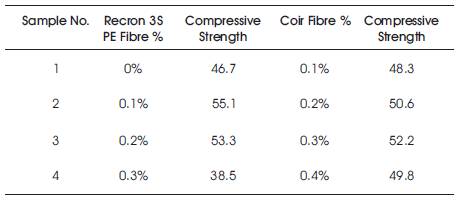
Table 4. Compression Strength Test Results

Figure 3. Compressive Strength of Paver Blocks with Recron 3S Polyester and Coir Fibres
According to ASTM C 140 Water Absorption, the average absorption of the test samples shall not be greater than 5% with no individual unit greater than 7%. The Water absorption values of the concrete paver blocks at the age of 28 days are determined and the results are presented in Table 5 and a graph drawn for Water Absorption of paver blocks with Recron 3S polyester and Coir Fibres is shown in Figure 4.
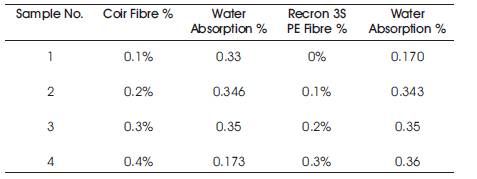
Table 5. Water Absorption Values of Paver Blocks

Figure 4. Water Absorption of Paver Blocks with Recron 3S Polyester and Coir Fibres
According to IS: 13311 (Part 2) – 1992, Methods of nondestructive testing of concrete Rebound Hammer, the compressive strength of the standard paver blocks and the paver blocks with polyester and coir fibres found using rebound hammer test were as shown below in Table 6 and a graph drawn for Compressive strength of paver blocks with Coir fibre and Recron 3S Polyester Fibres by Rebound Hammer as shown in Figure 5.
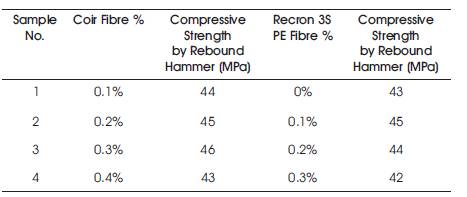
Table 6. Rebound Hammer Values of Paver Blocks

Figure 5. Compressive Strength of Paver Blocks with Coir Fibre and Recron 3S Polyester Fibres by Rebound Hammer
According to IS: 13311 Part-I 1992 Ultrasonic testing uses a high-frequency sound energy to conduct examinations and make measurements. Ultrasonic inspection can be used for flaw detection, the UPSV results are been tabulated for both Coir and Recron 3S PE fibre as shown in Table 7 and Correlation between Ultrasonic Pulse Velocity test and Compressive the strength of Paver Blocks when modified by the addition of coir fibers is shown in Figure 5.
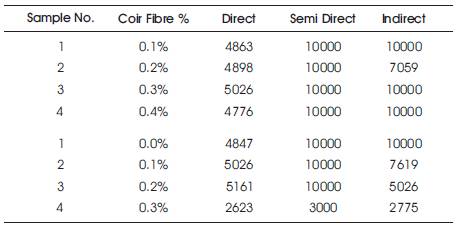
Table 7. UPSV Test Results
Regression analysis was computed on the data obtained was using 'MS Excel' software. The correlation coefficient between compressive strength and UPSV for coir fibre paver blocks is 0.8072 as shown in Figure 6.

Figure 6. Correlation between Ultrasonic Pulse Velocity Test and Compressive the Strength of Paver Blocks when Modified by the Addition of Coir Fibers
The correlation coefficient for Recron 3S PE fibres is 0.6359 as shown in Figure 7. If the regression value is greater than 0.8 then the concrete is said to be good concrete.

Figure 7. Correlation between Ultrasonic Pulse Velocity Test and Compressive Strength of Paver Blocks when Modified by Addition of Recron-3S PE Fibres
The cost of fibre reinforced paver blocks have been compared with the cost of conventional concrete paver blocks shown below in Tables 8 and 9.
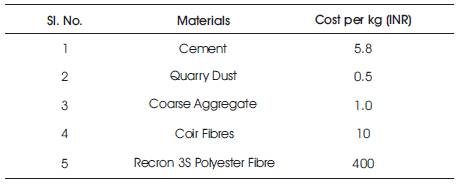
Table 8. Cost of Materials used
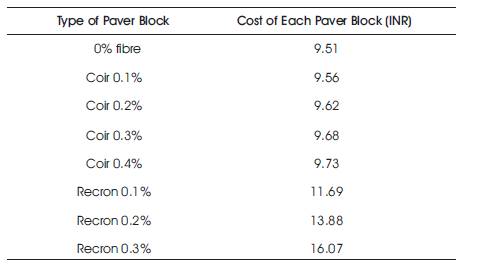
Table 9. Cost Comparison of Paver Blocks
In this experimental study, the following value conclusions are drawn based on the experimental test results and discussions.